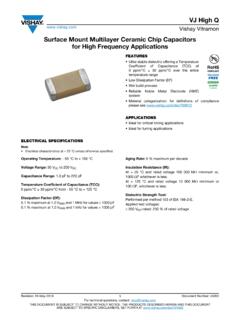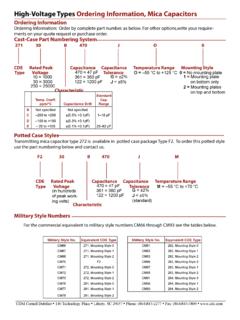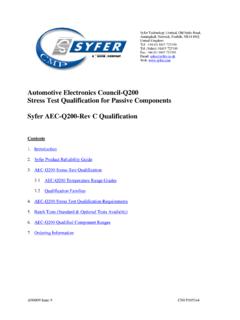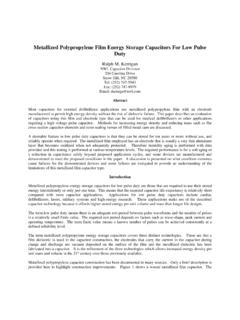Transcription of Failure mechanisms in ceramic capacitors - …
1 Failure mechanisms in ceramic capacitorsDesign and process issuesHandling damageCauses of flexure damageMultilayer ceramic capacitors (MLCs) have become one of the most widely used components inthe manufacture of surface mount assemblies, and are inherently very reliable. However, allceramics are brittle, and when layout design and manufacturing methods do not to take this intoaccount, these normally trustworthy devices can fail unexpectedly, either immediately or (arguablymuch more seriously) during on what you know about the construction and materials of a chip ceramiccapacitor if necessary, reread ceramic components. What are the possible ways in which such a capacitor might fail?
2 Design and process issuesOne cause of unreliability is failing to design boards to minimise the considerable thermal stressesto which MLCs are subjected during soldering. These arise from mismatches in CTE, bothbetween the capacitor and the board on which it is mounted and between the different materialswhich make up the MLC is constructed of alternate layers of silver/palladium (Ag/Pd) alloy, with a CTE ofaround 20 ppm/ C, and ceramic with a CTE of 10 12 ppm/ C. When this composite structureis heated, the electrodes tend to force the capacitor apart. This tendency is made worse by Ag/Pdbeing a much better conductor of heat (>400 ) than ceramic (4 5 ), so that athermal gradient will exist across the ceramic solder terminations also expand at a greater rate (25 30 ppm/ C) than the ceramic part andexert an annular tensile force on the edges of the component.
3 In severe cases, when a largesurface mounted capacitor has been subjected to a sudden thermal shock, a clearly visibleelliptical crack may form on the upper surface of the chip (Figure 1). This is primarily due to thetensile forces exerted by the obvious is the creation of micro-cracks under the visible surface of the capacitor, whichpropagate along isothermal lines within the component (Figure 2). This form of damage isparticularly insidious, since electrical Failure may not occur until some time after assembly, whenthe finished product is out in the field. Figure 2: Micro-cracking under thermal stress After a number of temperature excursions, for example due to circuit operation, the crack may propagate (Figure 3), creating an open-circuit device.
4 In severe cases, the body of the capacitor may even fall out, leaving just remnants of ceramic surrounded by termination and solder joints. Figure 1: Extreme thermal shock cracks in MLCs Figure 3: Propagation of a micro-crackFortunately, improvements in ceramic technology have reduced the incidence of both types ofcrack, at least as far as well-made components are concerned. It has been commented that thereflow process is unlikely to cause failures unless parts have already been , component reliability can be further improved by appropriate choice of solderingconditions:Most problems in wave soldering can be overcome by reducing the solder bathtemperature (to 235 245 C) and controlling the pre-heatIn reflow soldering, excessively high rates of temperature rise during preheatshould be avoided, as these can cause micro-cracking.
5 The conditions forminimum Failure rates depend on the reflow process used, but it is usuallyrecommended that MLCs should not be subjected to rates of change oftemperature of more than 2 C/second. There is some evidence that a steadyrate of change is more important than the absolute rate of heating, and that therate of cooling is less important than the rate of heatingHand soldering during rework has been shown to damage components, so it isCapacitor missing after severe crackingrecommended that the iron bit should never come into direct contact with parts,instead using solder for heat most components are now correctly specified and manufactured for surface mounting,this was not always the case, and reference should always be made to the manufacturer s datasheets.
6 Where a simple thermal shock test is needed, this can be done by immersing sample partsin a solder bath at 260 C (simulating the worst case soldering process), testing the partselectrically both before and after solder immersion. Handling damageWhen a circuit board is bent, its shape tries to become an arc of a circle, as far as the rigidity ofthe attached components will allow. The outer surface stretches and the distance between thecomponent lands is increased, placing the chip under tension: conversely, on the inner surface, anMLC is exposed to compressive strain. Whilst any joint will stress-relieve, given time, in the shortterm only a limited degree of stress reduction can come from deformation of the solder joint.
7 Ifthe forces applied to the chip exceed its breaking strength, the chip will crack! Cracked capacitorStress is a force which produces (or tends to produce) deformation, and is measured as the forceapplied per unit of is the deformation which results from a stress, and is measured as the ratio of the changeto the total value of the dimension in which the change occurred. As with CTE, strain isdimensionless, and usually quoted in micro-strain .Figures for the maximum level of strain which can be tolerated by an MLC vary betweensuppliers and between types, but may be as low as 1000 1500 which are created as a result of board bending typically look quite different fromthermally-induced cracks, being contained within the terminated area, as shown in Figure 4,running from the edge of the termination towards the end face of the chip.
8 Figure 4: MLC cracking due to board stress or warpageThe consequences of these cracks are serious, especially as they are usually not visible, andimmediate changes in key parameters are rare. Syfer Technology report that cracks are visible atthe exterior in less than 2% of affected parts and change of capacitance is a feature of no morethan about 10% of broken chips . The parameter affected is usually insulation resistance (IR),where some 60% of damaged parts exhibit a detectable change. However, only a small minorityare actually identified as potential failures before use. The problem is complicated in a number ofways.
9 In-circuit tests can rarely apply sufficient voltage and/or time for realistic IRmeasurementThe electrical problem may be intermittent, with the Failure masked duringmanufacture as a result of thermal treatment or by probe pressure, but failinglaterMost functional tests are not sensitive even to the omission of capacitors usedin common decoupling or EMC suppression applicationsBending-induced cracks in an MLCS imilarly, many decoupling or EMC suppression capacitors may be damagedand defective without affecting circuit function in normal seriously, what starts as a modest reduction in IR can degrade to the point where the circuitfails to work, due to penetration of the crack structure by atmospheric moisture.
10 Totalshort-circuits are less common, but have been known to cause catastrophic board loss (fromburn-out) in designs where the fault current was not presence of micro-cracks can in theory be detected by subjecting the chip to a high voltageinsulation resistance test at 85 C and 85% relative humidity. However, several other factors mayalso lower the insulation resistance in this way, especially poor choice of cleaning solvents, or theuse of solvents containing large amounts of dissolved flux sensitive tests for micro-cracks and delamination apply a mobile ionic material such asmethanol to the part, measuring IR changes. However, the effects can be similarly obscured alternative (and non-destructive) method is scanning acoustic microscopy (SAM), which usesan ultrasonic transducer, typically operating at 10 MHz to 100 MHz, with the componentimmersed in fluid (usually water) to couple it to the transducer.











